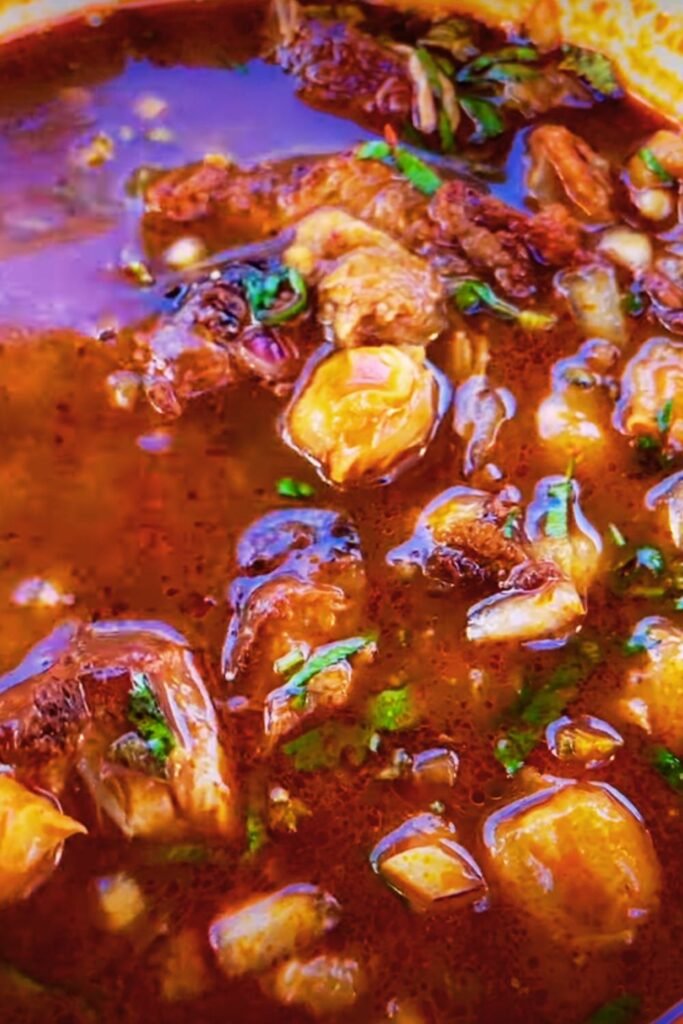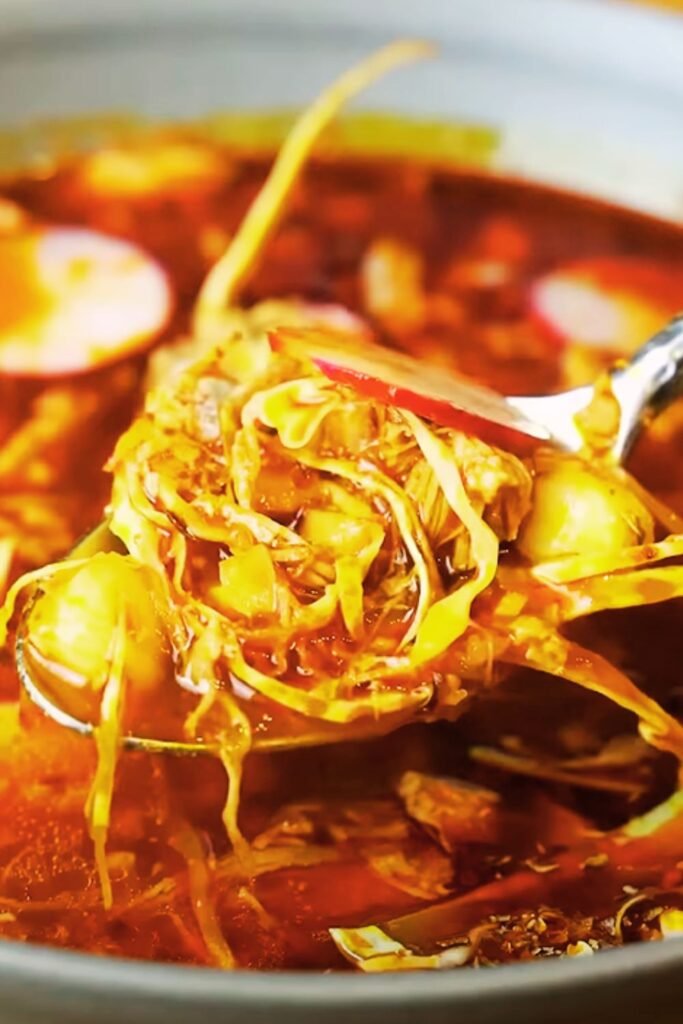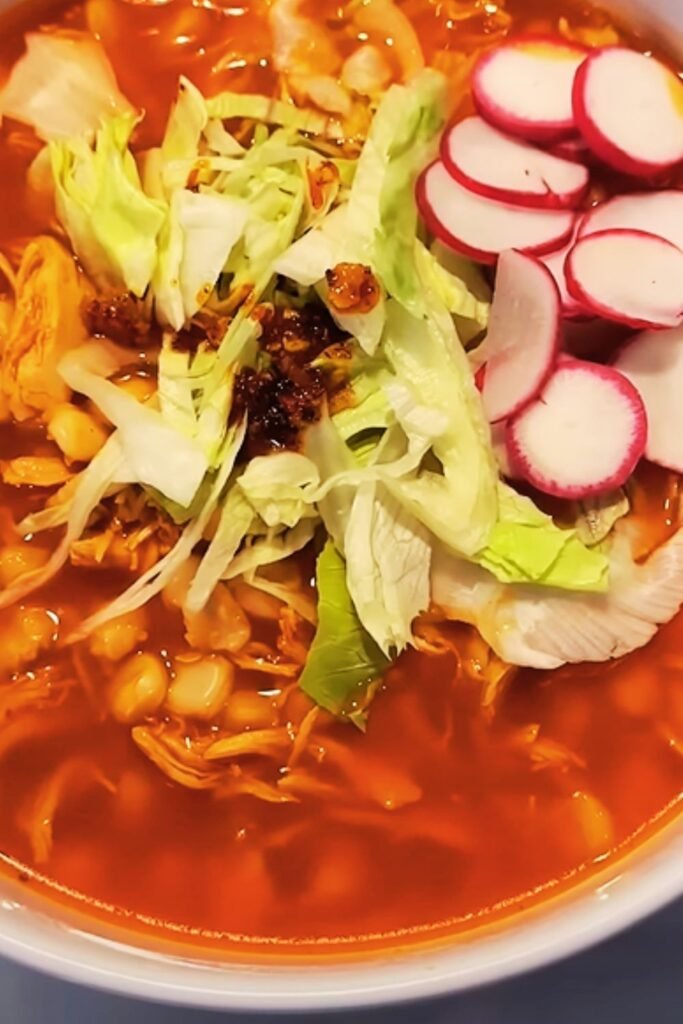When I first tasted authentic pozole at a small family restaurant in Guadalajara, I knew my life had changed forever. The rich, complex broth, tender hominy kernels, and perfectly seasoned pork created a symphony of flavors that transported me straight to the heart of Mexican culinary tradition. That moment sparked my decade-long journey to master this incredible dish, and today I’m sharing everything I’ve learned about creating the most authentic pozole you’ve ever tasted.
Pozole isn’t just a soup – it’s a celebration, a tradition, and a testament to Mexico’s rich culinary heritage. This ancient dish, whose roots trace back to pre-Columbian civilizations, has evolved into one of Mexico’s most cherished comfort foods. Through countless experiments, conversations with Mexican grandmothers, and trips to different regions of Mexico, I’ve discovered that the secret to exceptional pozole lies not just in the ingredients, but in understanding the soul of this remarkable dish.
Understanding Pozole: More Than Just a Soup
Pozole: A traditional Mexican soup consisting of hominy corn kernels in a rich, flavorful broth, typically made with pork, chicken, or vegetables, served with an array of fresh garnishes.
Hominy: Dried corn kernels that have been treated with alkali (usually lime) in a process called nixtamalization, which removes the hull and germ, creating tender, chewy kernels with a distinctive flavor.
Nixtamalization: An ancient Mesoamerican process of treating corn with alkali to improve its nutritional value, flavor, and workability.
Chile Guajillo: Dried mirasol peppers with a deep red color and mild, sweet heat, essential for authentic red pozole.
Chile Ancho: Dried poblano peppers that provide rich, smoky flavor with mild heat.
Chile de Árbol: Small, fiery red chiles that add significant heat and bright flavor to pozole broth.
The beauty of pozole lies in its versatility and regional variations. During my travels through Mexico, I’ve encountered three main types: pozole rojo (red), pozole verde (green), and pozole blanco (white). Each region adds its own twist, but the foundation remains constant – tender hominy in a deeply flavorful broth that’s been simmered to perfection.
Essential Ingredients for Authentic Pozole
Creating authentic pozole requires specific ingredients that work together to create that distinctive flavor profile I fell in love with years ago. Through my experiences, I’ve learned that substitutions simply don’t deliver the same results.
Primary Ingredients
| Ingredient | Quantity | Purpose | Substitution Notes |
|---|---|---|---|
| Pork shoulder (Boston butt) | 3 lbs | Main protein, provides rich flavor | Can use pork ribs for more flavor |
| Pork trotters | 2 pieces | Adds body and gelatin to broth | Optional but recommended |
| White hominy | 2 cans (29 oz each) | Signature ingredient | Dried hominy preferred (soak overnight) |
| White onion | 2 large | Base flavor foundation | Yellow onion acceptable |
| Garlic | 8 cloves | Aromatic base | Never substitute garlic powder |
| Bay leaves | 4 leaves | Subtle background flavor | Mexican bay leaves preferred |
| Salt | 2 tablespoons | Seasoning | Sea salt or kosher salt |
Chile Blend for Red Pozole
| Chile Type | Quantity | Heat Level | Flavor Profile |
|---|---|---|---|
| Guajillo | 6 chiles | Mild | Sweet, fruity, earthy |
| Ancho | 4 chiles | Mild | Rich, smoky, slightly sweet |
| Chipotle | 2 chiles | Medium-hot | Smoky, complex |
| Chile de árbol | 3 chiles | Hot | Bright, clean heat |
Traditional Garnishes
The garnish station is where pozole truly shines. I’ve learned that the toppings aren’t just decorative – they’re integral to the complete pozole experience.
Essential Garnishes:
- Crisp iceberg lettuce, finely shredded
- Radishes, thinly sliced into rounds
- Mexican oregano, dried and crumbled
- Lime wedges, fresh and juicy
- White onion, finely diced
- Crushed red pepper flakes (piquín)
Regional Variations:
- Cabbage instead of lettuce (Northern Mexico style)
- Avocado slices (modern addition)
- Chicharrón pieces (for extra richness)
- Tostadas or corn tortilla chips

My Foolproof Method for Perfect Pozole
After years of refinement, I’ve developed a method that consistently produces restaurant-quality pozole at home. The key is patience and attention to detail at each step.
Step 1: Preparing the Meat
I start by cutting the pork shoulder into large chunks – about 3-4 inches each. This might seem large, but the meat will shrink during cooking, and larger pieces stay more tender. I season the meat generously with salt at least 30 minutes before cooking, allowing it to penetrate the meat.
In my largest pot, I place the pork pieces, pork trotters (if using), halved onions, 4 garlic cloves, and bay leaves. I cover everything with cold water by about 2 inches – usually around 3 quarts. The cold water start is crucial for extracting maximum flavor from the meat.
Step 2: The Long Simmer
I bring the pot to a gentle boil, then immediately reduce to a low simmer. This is where patience becomes your best friend. I let this simmer for 2-3 hours, skimming the foam and impurities every 20-30 minutes during the first hour. The meat is ready when it easily shreds with a fork.
During this time, I prepare my chile blend. I remove stems and most seeds from the chiles, then toast them in a dry skillet for 30 seconds per side until fragrant. I soak the toasted chiles in hot water for 20 minutes until soft.
Step 3: Creating the Chile Base
This step separates good pozole from extraordinary pozole. I blend the soaked chiles with 2 cups of their soaking liquid, remaining garlic cloves, and a teaspoon of salt until completely smooth. The mixture should have the consistency of heavy cream.
I strain this mixture through a fine-mesh sieve to remove any remaining bits of skin or seeds. This extra step ensures a silky-smooth broth without any grittiness.
Step 4: Bringing It Together
Once the meat is tender, I remove it from the broth and shred it when cool enough to handle. I strain the broth through a fine-mesh sieve, discarding the solids, and return the clear broth to the pot.
I add the chile mixture to the strained broth and simmer for 30 minutes to marry the flavors. Then I add the drained hominy and shredded pork, simmering for another 15 minutes. I taste and adjust seasoning – this is crucial for perfect pozole.

Regional Variations I’ve Discovered
My travels through Mexico have revealed fascinating regional differences in pozole preparation. Each area has developed unique characteristics that reflect local ingredients and preferences.
Pozole Rojo (Red Pozole)
This is the version most people recognize, featuring that beautiful deep red color from dried chiles. Jalisco-style pozole rojo, which I learned in Guadalajara, uses a blend of guajillo and ancho chiles for a mild, complex flavor. Michoacán-style includes chipotle chiles for additional smokiness.
Pozole Verde (Green Pozole)
Popular in Guerrero state, green pozole gets its color from fresh ingredients like cilantro, lettuce, and green chiles. I’ve found that poblano peppers, tomatillos, and pumpkin seeds create the distinctive green base. The flavor is brighter and more herbaceous than red pozole.
Pozole Blanco (White Pozole)
The most ancient version, white pozole contains no added chiles in the broth itself. All heat comes from the garnishes. This version allows the pure corn and pork flavors to shine through. I particularly enjoy white pozole with extra spicy garnishes.
Nutritional Benefits and Health Considerations
Pozole offers remarkable nutritional value, making it both delicious and healthful. The nixtamalization process that creates hominy actually increases the bioavailability of niacin (Vitamin B3) and calcium in the corn.
Nutritional Breakdown (per serving)
| Nutrient | Amount | % Daily Value |
|---|---|---|
| Calories | 385 | 19% |
| Protein | 28g | 56% |
| Carbohydrates | 32g | 11% |
| Fiber | 8g | 32% |
| Iron | 3.2mg | 18% |
| Zinc | 4.1mg | 37% |
| Vitamin B6 | 0.8mg | 47% |
| Niacin | 12mg | 75% |
The combination of complete proteins from pork and complementary proteins from corn creates a nutritionally complete meal. The high fiber content from hominy supports digestive health, while the mineral content supports immune function.
Mastering the Perfect Consistency
One challenge I initially faced was achieving the ideal consistency. Pozole should be brothier than a stew but heartier than a typical soup. The hominy should be tender but still have a slight bite, and the broth should coat a spoon lightly.
If your pozole is too thin, simmer it uncovered to reduce the liquid. If it’s too thick, add warm chicken or vegetable broth. I’ve learned to make adjustments gradually – it’s easier to thin than to thicken.
The hominy timing is critical. Canned hominy needs only 15 minutes to heat through and absorb flavors. Dried hominy, which I prefer for its superior texture, requires overnight soaking and 2-3 hours of cooking time.
Storage and Reheating Tips
Pozole actually improves with time as the flavors meld and develop. I often make large batches and store portions for later meals. The soup keeps in the refrigerator for up to 5 days and freezes beautifully for up to 3 months.
When reheating, I add a splash of broth or water to restore the proper consistency. I always reheat gently to prevent the pork from becoming tough. Garnishes should always be fresh – never store pozole with the toppings added.

Troubleshooting Common Issues
Through years of making pozole and teaching others, I’ve encountered and solved numerous common problems:
Bland Broth: Usually results from insufficient browning of aromatics or inadequate seasoning. Always taste and adjust salt levels throughout cooking.
Tough Meat: Indicates insufficient cooking time or too high heat. Pork shoulder needs long, gentle cooking to become tender.
Grainy Chile Sauce: Occurs when chiles aren’t properly soaked or strained. Always strain through fine mesh for smooth results.
Mushy Hominy: Overcooking causes this. Add canned hominy only for the final 15 minutes of cooking.
Greasy Broth: Remove excess fat by chilling the broth and skimming solidified fat, or use a fat separator.
Serving Suggestions and Accompaniments
Pozole is traditionally served as the centerpiece of a meal, but I’ve discovered wonderful complementary dishes through my experiences:
Traditional Accompaniments:
- Warm corn tortillas or tostadas
- Mexican crema or sour cream
- Fresh cheese (queso fresco or Monterey Jack)
- Pickled jalapeños
- Salsa verde or red salsa
Modern Additions I Enjoy:
- Grilled corn tortillas brushed with garlic oil
- Avocado slices seasoned with lime and salt
- Crispy tortilla strips for added texture
- Hot sauce selection for heat preferences
The beauty of pozole lies in its customization. Each person can create their perfect bowl with their preferred combination of garnishes.
Cultural Significance and Traditions
My journey with pozole has taught me that this dish represents much more than sustenance. In Mexican culture, pozole is deeply connected to celebration and community. Traditionally served on special occasions like Christmas, New Year’s, and Independence Day, pozole brings families together around the table.
During my time in Mexico, I observed that making pozole is often a communal activity. Families gather to prepare garnishes, share stories, and bond over the cooking process. The dish serves as a bridge between generations, with recipes and techniques passed down through families.
Understanding this cultural context has made my own pozole preparation more meaningful. When I make pozole now, I think of it as participating in a tradition that spans centuries and connects me to countless families who have shared this remarkable dish.
Questions and Answers
Q: Can I make pozole in a slow cooker or pressure cooker? A: Absolutely! I use my pressure cooker regularly for pozole. Cook the pork with aromatics under high pressure for 90 minutes, then add the chile sauce and hominy for the final 15 minutes. Slow cookers work well too – cook on low for 8 hours for the meat phase, then add chiles and hominy for the final hour.
Q: What’s the difference between white and yellow hominy for pozole? A: Both work perfectly in pozole. White hominy has a slightly milder corn flavor, while yellow hominy is a bit more robust. I prefer white hominy for its traditional appearance, but the choice is purely personal preference.
Q: Can I make vegetarian pozole that still tastes authentic? A: Yes! I create vegetarian versions using vegetable broth enriched with mushrooms, especially dried shiitake and porcini. The umami from mushrooms helps replicate some of the depth that pork provides. Add extra garlic and onion for complexity.
Q: How spicy should authentic pozole be? A: Traditional pozole broth is actually quite mild – most heat comes from garnishes and hot sauce added individually. The chile blend provides more flavor and color than heat. This allows everyone to customize their spice level.
Q: Why does my pozole broth look cloudy instead of clear? A: Cloudy broth usually results from boiling rather than simmering, or from not skimming the foam during initial cooking. Always maintain a gentle simmer and skim regularly during the first hour of cooking for crystal-clear broth.
Q: Can I substitute chicken for pork in pozole? A: Chicken works well, though the flavor will be different. Use bone-in chicken thighs and drumsticks for best results. The cooking time reduces to about 1 hour for tender chicken. Some regions of Mexico do make chicken pozole traditionally.
Q: How far in advance can I prepare pozole for a party? A: Pozole is perfect for entertaining because it can be made 1-2 days ahead. The flavors actually improve with time. Reheat gently before serving and prepare fresh garnishes. The garnish preparation can be done several hours ahead and kept refrigerated.
Q: What’s the best way to store leftover pozole? A: Store the soup separately from garnishes in the refrigerator for up to 5 days. For longer storage, freeze in portions for up to 3 months. Always cool completely before refrigerating and reheat gently to prevent the meat from becoming tough.
Q: Are there gluten-free considerations with pozole? A: Traditional pozole is naturally gluten-free since it’s made with corn, meat, and chiles. However, always check labels on canned hominy and any additional seasonings to ensure they don’t contain gluten-containing additives.
Q: What size pot do I need for a full batch of pozole? A: I recommend at least an 8-quart pot for a full batch that serves 8-10 people. The large volume is necessary to properly cover the meat with water and allow for proper simmering without overflow. A smaller 6-quart pot works for half batches.